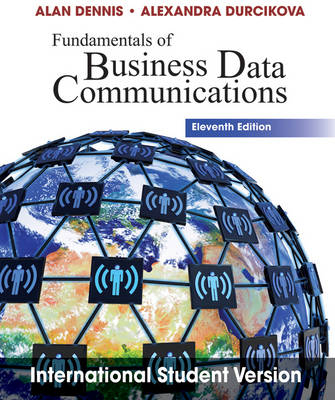
Fundamentals of Business Data Communications
John Wiley & Sons Inc (Verlag)
978-1-118-09792-2 (ISBN)
- Titel ist leider vergriffen;
keine Neuauflage - Artikel merken
Professor Alan Dennis is professor of information systems in the Kelley School of Business at Indiana University and holds the John T. Chambers Chair in Internet Systems. The Chambers Chair was established to honor John Chambers, president and chief executive officer of Cisco Systems, the worldwide leader of networking technologies for the Internet. Prior to joining Indiana University, Professor Dennis spent nine years as a professor at the University of Georgia, where he won the Richard B. Russell Award for Excellence in Undergraduate Teaching. Professor Dennis has a bachelor's degree in computer science from Acadia University in Nova Scotia, Canada, and an MBA from Queen's University in Ontario, Canada. His Ph.D. in management of information systems is from the University of Arizona. Prior to entering the Arizona doctoral program, he spent three years on the faculty of Queen's School of Business. Dr. Jerry Fitzgerald is the principal in Jerry Fitzgerald & Associates, a firm he started in 1977. He has extensive in risk analysis, computer security, audit and control of computerized systems, data communications, networks, and systems analysis. He has been active in risk-assessment studies, computer security, audit reviews, designing controls into applications during the new system development process, date communication networks, bank wire transfer systems, and electronic data interchange and date communication networks. Dr. FitzGerald has a Ph.D.in business economics and a master's degree in business economics from the Claremont Graduate School, an MBA from the University of Santa Clara, and a bachelor's degree in industrial engineering from Michigan State University. He is a certified information systems auditor (CISA) and holds a certificate in data processing (CDP). He belongs to the EDP Auditors Association (EDPAA), the Institute of Internal Auditors (IIA), and the Information Systems Security Association (ISSA). Dr. FitzGerald has been a faculty member at several California universities and a consultant at SRI International. Alexandra Durcikova is an Assistant Professor at the Eller College of Business, University of Arizona. Alexandra has a Ph.D. in Management Information Systems from University of Pittsburgh. She has earned a M.Sc. degree in Solid States Physics from Comenius University, Bratislava, worked as an experimental physics researcher in the area of superconductivity and as an instructor of executive MBA students prior to pursuing her Ph.D. Alexandra's research interests include knowledge management and knowledge management systems, knowledge management system characteristics, governance mechanisms in the use of knowledge management systems; and human compliance with security policy and characteristics of successful phishing attempts within the area of network security. Her research appears in Information Systems Research, Journal of Management Information Systems, International Journal of Human-Computer Studies, and Communications of the ACM.
PART ONE - INTRODUCTION CHAPTER 1 INTRODUCTION TO DATA COMMUNICATIONS 1.1 INTRODUCTION 1.2 DATA COMMUNICATIONS NETWOKS 1.3 NETWORK MODELS 1.4 NETWORK STANDARDS 1.5 FUTURE TRENDS 1.6 IMPLICATIONS FOR MANAGEMENT SUMMARY PART 2 - FUNDAMENTAL CONCEPTS CHAPTER 2 NETWORK APPLICATIONS 2.1 INTRODUCTION 2.2 APPLICATION ARCHITECTURES 2.3 WORLD WIDE WEB 2.4 ELECTRONIC MAIL 2.5 OTHER APPLICATIONS 2.6 IMPLICATIONS FOR MANAGEMENT SUMMARY CHAPTER 3 CIRCUITS AND TRANSMISSION 3.1 INTRODUCTION 3.2 CIRUITS 3.3 COMMUNICATION MEDIA 3.4 DIGITAL TRANSMISSION OF DIGITAL DATA 3.5 ANALOG TRANSMISSION OF ANALOG DATA 3.6 DIGITAL TRANSMISSION OF ANALOG DATA 3.7 IMPLICATIONS FOR MANAGEMENT SUMMARY CHAPTER 4 DATA LINK LAYER 4.1 INTRODUCTION 4.2 MEDIA ACCESS CONTROL 4.3 ERROR CONTROL 4.4 DATA LINK PROTOCOLS 4.5 TRANSMISSION EFFICIENCY 4.6 IMPLICATIONS FOR MANAGEMENT SUMMARY CHAPTER 5 TCP/IP 5.1 INTRODUCTION 5.2 TRANSPORT AND NETWORK LAYER PROTOCOLS 5.3 TRANSPORT LAYER FUNCTIONS 5.4 ADDRESSING 5.5 ROUTING 5.6 TCP/IP EXAMPLE 5.7 IMPLICATIONS FOR MANAGEMENT PART THREE - NETWORK TECHNOLOGIES CHAPTER 6 WIRED AND WIRELESS LOCAL AREA NETWORKS 6.1 INTRODUCTION 6.2 LAN COMPONENTS 6.3 WIRED ETHERNET 6.4 WIRELESS ETHERNET 6.5 THE BEST PRACTICE LAN DESIGN 6.6 IMRPOVING LAN PERFORMANCE 6.7 IMPLICATIONS FOR MANAGEMENT SUMMARY CHAPTER 7 BACKBONES 7.1 INTRDUCTION 7.2 BACKBONE NETWORK COMPONENTS 7.3 BACKBONE NETWORK ARCHITECTURES 7.4 THE BEST PRACTICE BACKBONE DESIGN 7.5 IMPROVING BACKBONE PERFORMANCE 7.6 IMPLICATIONS FOR MANAGEMENT SUMMARY CHAPTER 8 WIDE AREA NETWORKS 8.1 INTRODUCTION 8.2 CIRCUIT-SWITCHED NETWORKS 8.3 DEDICATED-CIRCUIT NETWORKS 8.4 PACKET-SWITCHED NETWORKS 8.5 VIRTUAL PRIVATE NETWORKS 8.6 THE BEST PRACTICE WAN PERFORMANCE 8.7 IMPROVING WAN PERFORMANCE 8.8 IMPLICATIONS FOR MANAGEMENT SUMMARY CHAPTER 9 THE INTERNET 9.1 INTRODUCTION 9.2 HOW THE INTERNET WORKS 9.3 INTERNET ACCESS TECHNOLOGIES 9.4 THE FUTURE OF THE INTERNET 9.5 IMPLICATIONS FOR MANAGEMENT SUMMARY PART FOUR - NETWORK MANAGEMENT CHAPTER 10 SECURITY 10.1 INTRODUCTION 10.2 RISK ASSESSMENT 10.3 ENSURING BUSINESS CONTINUITY 10.4 INTRUSION PREVENTION 10.5 BEST PRACTICE RECOMMENDATIONS 10.6 IMPLICATIONS FOR MANAGEMENT SUMMARY CHAPTER 11 DESIGNING NETWORKS 11.1 INTRODUCTION 11.2 NEEDS ANALYSIS 11.3 TECHNOLOGY DESIGN 11.4 COST ASSESSMENT 11.5 DESIGNING FOR NETWORK PERFORMANCE 11.6 IMPLICATION FOR MANAGEMENT SUMMARY CHAPTER 12 NETWORK ADMINISTRATION 12.1 INTRODUCTION 12.2 ORGANIZING THE NETWORK MANAGEMENT FUNCTION 12.3 CONFIGURATION MANAGEMENT 12.4 PERFORMANCE AND FAULT MANAGEMENT 12.5 END USER SUPPORT 12.6 COST MANAGEMENT 12.7 IMPLICATIONS FOR MANAGEMENT SUMMARY PART FIVE - APPENDICES APPENDIX A CONNECTOR CABLES APPENDIX B SPANNING TREE PROTOCOL APPENDIX C IP TELEPHONY APPENDIX D TCP/IP GAME GLOSSARY INDEX
| Erscheint lt. Verlag | 30.12.2011 |
|---|---|
| Verlagsort | New York |
| Sprache | englisch |
| Maße | 192 x 235 mm |
| Gewicht | 832 g |
| Themenwelt | Mathematik / Informatik ► Informatik ► Netzwerke |
| Informatik ► Office Programme ► Outlook | |
| ISBN-10 | 1-118-09792-0 / 1118097920 |
| ISBN-13 | 978-1-118-09792-2 / 9781118097922 |
| Zustand | Neuware |
| Haben Sie eine Frage zum Produkt? |
aus dem Bereich


